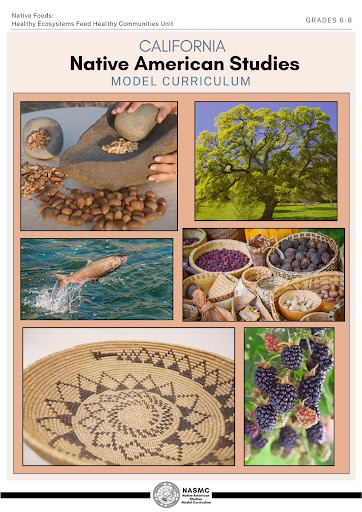Overview
Free Resources!
Native Foods for Today’s World

Author: This unit was researched, authored, and edited by the California Indian Museum and Cultural Center, California Indian Education for All, and the San Diego County Office of Education. Key writers and researchers of this unit are Nicole Lim, Jayden Lim, and Dr. Staci Block. The unit resources were designed and created from funding through the California Department of Education’s Native American Studies Model Curriculum grant and contract.
Grade(s): 6th-8th Grades
Suggested Amount of Time: 60 minute
Curriculum Themes
- History
- Relationship to Place
Learning Goals
Understand the role of traditional Native foods in California’s ecosystems and cultures.
Recognize the impacts of historical policies on Native diets and health.
Explore how Native communities are working toward food sovereignty today.
Reflect on their own food traditions and their connection to culture and health.
Lesson Overview
This lesson introduces students to traditional Native foods of California, exploring their health benefits, cultural significance, and connection to food sovereignty. Students will examine how food practices have evolved due to historical changes and learn how Native communities are revitalizing traditional foodways to promote health, sustainability, and cultural pride.
Teacher Background
In this lesson students are introduced to traditional Native foods in California and learn about food sovereignty. Students explore contemporary examples of California Native foods that range in style, method, and degree of tradition. Students learn that Native foods are diverse, tasty, and healthy.
Traditional Native foods in California reflect the state’s biodiversity and the deep ecological knowledge of its Indigenous peoples. Foods like acorns, berries, mushrooms, and salmon were historically abundant due to sustainable practices such as cultural burning and responsible harvesting. These practices ensured balance within ecosystems. The arrival of settlers disrupted traditional foodways through land seizure, bans on cultural practices, and federal policies that introduced processed rations to Native diets. These changes led to significant health disparities, including diabetes and obesity. Today, Native communities are reclaiming their food traditions to restore health, food sovereignty, and cultural identity.
Native or Indigenous foods in North American vary dramatically depending on their geographic region. California Natives have traditionally enjoyed an abundance of food options as a result of the wide biodiversity of the land. The practice of Traditional Ecological Knowledge (TEK), methods for tending the landscape that have been developed over thousands of years by Native people, specifically aims to ensure ample food production across California’s varied landscapes.
As settlers seized land from Native peoples, regulations were put in place that banned the use of many TEK practices, such as cultural burning, traditional salmon fishing, and hunting. These practices were instead replaced with the construction of dams, the development of protected wildlands on which maintenance and “interference” by humans was severely limited, deforestation, and mining, which polluted waterways once relied upon for food. Traditional methods for obtaining cultural foods became difficult to practice.
In addition to these environmental regulatory shifts, federal policy aimed at assimilation discouraged and forbade traditional Tribal practices, often leading to changes in diet that accompanied the placement of Native peoples onto reservations. On reservations, Native communities found themselves with little to no infrastructure, no economic prospects, and on top of that, reservations were generally located in areas that were difficult to farm. Because Natives had few, if any, food sources, the US government began to issue food rations, usually consisting of flour, coffee, tea, and beef. This massive shift in the types of foods consumed by Natives has led to enormous health disparities. Diseases most common in Indian Country are diabetes, coronary health disease, and obesity. Many reservation residents still depend on these rations today.
Across the United States, Tribal communities are reinvigorating their traditional foodways as a way of supporting food sovereignty. Because of the negative impact of Western food on Native health, communities are working to reintroduce traditional foods and food production methods into their communities. In many cases, this traditional knowledge was never truly lost. Some methods of supporting food sovereignty are: developing community health centers that grow and distribute healthy Indigenous foods to Native families, community gathering and hunting trips, using traditional trapping and fishing methods on traditional waterways, and envisioning Native foods through a modern lens in Native owned restaurants and businesses.
As the general public becomes more aware of the foods Indigenous to the places they live, multiple understandings are strengthened. First, it becomes obvious that Westernized, processed foods can be poisonous to the body, and are incredibly detrimental to Native peoples and people who have little access to affordable healthy foods. Westernized, processed foods should be consumed in limited quantities. Second, supporting Indigenous foods means supporting the ecosystem in a way that avoids overconsumption. When advocating for the consumption of local, Indigenous foods, communities must consider how that food is being cultivated and collected, and how humans are ensuring the health of the food web in order to promote new growth the following season. Lastly, traditional foods in Native communities are cultivated and consumed using culturally specific methods and ideologies, ones that are integrally connected to story, song, and ceremony. Non-Natives should take time to consider these things when thinking about how to incorporate traditional foods into their own diets so as to be respectful to Native communities who rely on these foods and avoid appropriating cultural traditions.